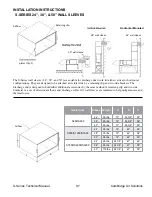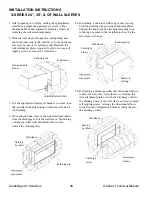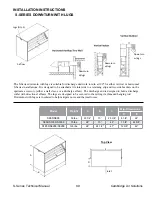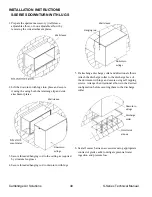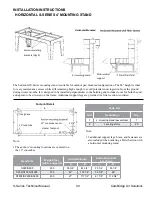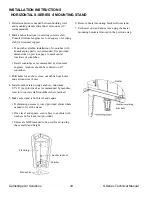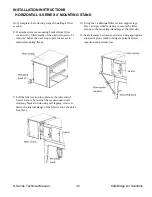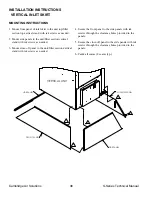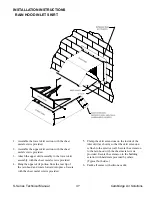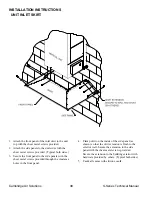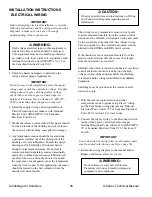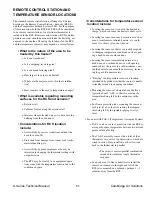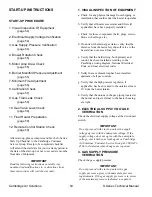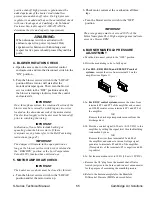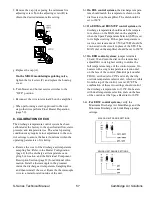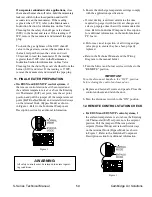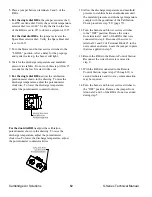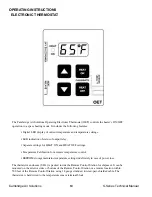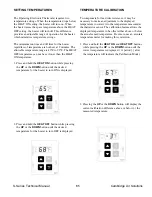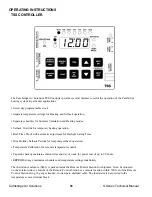
S-Series Technical Manual
51
Cambridge Air Solutions
The standard remote control station offerings for S-Series
heaters are the Remote Control Station – Security (RCS-S)
and the Temperature Setback System (TSS). For the purpose
of this discussion, both the RCS-S & TSS will be considered
to be remote control stations. An electronic thermostat is
included in the RCS. Remote control stations (RCS) and tem-
perature sensor(s) should be mounted inside the building, not
exposed to the weather. Choosing the locations for the RCS
and the temperature sensor(s) may depend on several factors:
• What is the nature of the area to be
heated by this heater?
o Is it in a warehouse?
o Is it a shipping/ receiving area?
o Is it in a manufacturing plant?
o How large is the area to be heated?
o Where are the major sources of cold air infiltra-
tion?
o How sensitive is the area to temperature changes?
• What is available regarding mounting
surfaces for the RCS and sensors?
o Exterior wall
o Columns located along the exterior wall
o Interior columns located one or two bays into the
building from the dock doors
• Considerations for RCS location
include:
o Accessibility by service technicians without the
need for a man lift
o Protection from damage from cranes, fork trucks,
material handling, etc.
o Accessibility by plant employees who may be
interested in changing the thermostat settings with-
out permission
o The RCS may be located in an equipment/opera-
tions room with the temperature sensors run to the
conditioned space.
• Considerations for temperature sensor
location include:
o Locating the sensor so it is not in the heater dis-
charge, which can cause the heater to short cycle.
o Locating the sensor near any heat sources such as
ovens, transformers, infrared heaters, etc. could
cause it to short cycle or not turn on.
o Locating the sensor so that it can readily respond
to changing temperature conditions, such as open-
ing a dock door or overhead door.
o Locating the sensor immediately adjacent to a
dock door, an overhead door or a wall opening
could subject the sensor to a cold airstream, caus-
ing the heater to run more than necessary, increas-
ing the gas bill unnecessarily.
o “Burying” the temperature sensor in a location
surrounded by product so that the sensor is unable
to readily respond to changing conditions.
o Mounting the sensor at a height above the floor,
typically about 5’ AFF, so that it is sensing the
temperature being felt by the employees in the
area.
o For freeze protection jobs, mounting the sensor at
roof joist level, so that it is sensing the tempera-
ture being felt by the sprinkler piping (wet sys-
tem).
• For a unit with TAS-2 (Temperature Averaging System)
o TAS-2 can be used in conjunction with the RCS to
average the space temperature between two distant
points within a facility.
o The TAS-2 assembly comes with a total of four
thermistors, two sets of two thermistors, which are
wired in series. Once installed, each set is wired
back to the thermostat in parallel.
• The result is a series/parallel combination
intended to simulate a single thermistor
response.
o In a dock area, it often is beneficial to install the
sensors on columns to the right and left of the
RCS (also mounted on a column), perhaps 1 – 2
columns away from the RCS.
REMOTE CONTROL STATION AND
TEMPERATURE SENSOR LOCATIONS
Содержание S Series
Страница 93: ...S Series Technical Manual 91 Cambridge Air Solutions REFERENCE ELECTRICAL CONTROL ENCLOSURE ISOMETRIC DRAWING ...
Страница 100: ...Cambridge Air Solutions 98 S Series Technical Manual REFERENCE BUILDING AUTOMATION SYSTEM ...
Страница 112: ...Cambridge Air Solutions 110 S Series Technical Manual MAINTENANCE LOG MODEL NO SERIAL NO Date Activity Technician ...
Страница 113: ...MAINTENANCE LOG MODEL NO SERIAL NO Date Activity Technician ...
Страница 114: ...Cambridge Air Solutions 112 S Series Technical Manual ...
Страница 116: ...760 Long Road Crossing Dr Chesterfield MO 63005 Phone 636 532 2233 800 899 1989 Fax 636 530 6133 www cambridgeair com ...

